Gertrude Page – “The Kipling of Rhodesia”
Life and Family
Gertrude Eliza Page was born in 1872, at Erdington, Warwick. She was the daughter of John Elliott Page. He moved to this area when Gertrude was three and bought a coal and malting business at Bedford. He had had two wives, with three children by the first and seven by the second.
The Page family resided at “The Mount”, Aspley Heath, which John may have had built in 1880, then they moved to “Heatherbank” in 1882. John amassed five acres, by buying up the land from other landowners to build this house on, which was enough to build his house in some seclusion.
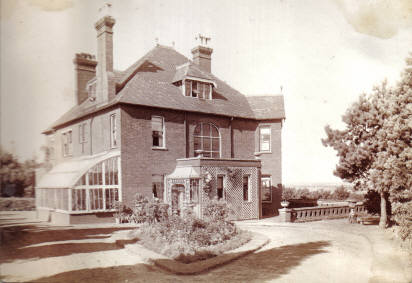
Whilst at this house, John entertained local dignitaries who were honouring a returning war hero, Major General Drury Curson Drury Lowe, C.B. Commander of the cavalry division of the Expeditionary force in Egypt, in 1882. John was also a local J.P., a Churchwarden at St Michael’s from 1890 – 1895, a Freemason and a Bedford Town Councillor from 1880-1883.
One of his sons was John Alfred Page, a noted architect, who worked at Bedford and later South America. Some of the plans he drew up are lodged at Bedfordshire and Luton Archives and Records Services at Bedford and were signed by him at “Heatherbank”. Another son, Joseph, was head of the Post Office on Taliana Island, off Vancouver.
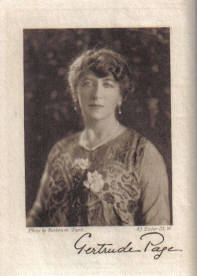
Gertrude is noted as having sung at concerts at the Woburn Sands Institute. She was educated at Bedford High School, then at a school on the south coast. When in her teens, she wrote a long novel that was accepted by the Girls Own Paper, and she later had many more stories published in it.
Her biography states that she wrote five more in the next seven years, but had no success in getting printed. The sixth was called Love in the Wilderness, which after some rewriting and polishing was accepted. One of the five before was Paddy the Next Best Thing, which later became her most successful novel. Yet the publishing date of Love in the Wilderness was 1907, when Gertrude was 35, so I think there was some contraction in the timeline used in the biography!
Her father John died 1901, aged 74, and was buried in Woburn Sands. His second wife had predeceased him by four years. Gertrude’s first book was dedicated: “Beloved Father, perfect gentleman”.
She married George Alexander Dobbin (known as Alec) in Kensington, London in 1902, after being together for at least a year, as the couple had sent flowers to her father’s funeral. They had no children. Alec had previously been out to South Africa with one of her brothers. He was refused for the Army but became a Red Cross driver. Alec was the son of Capt. R. A. Dobbin of the Indian Staff Corp. at Armagh and grandson of Leonard Dobbin, of Armagh. He was born December 17th, 1871.
The Dobbins were a prominent north Irish family with a history in banking and law as well as the army. It was likely that it was through the Dobbin family that Gertrude spent time in Omeath in County Louth, Ireland, as Leonard Dobbin was an agent for the local landlord and owned a large house in the village. It was here that her most famous novel, ‘Paddy the Next Best Thing’, was set. The house where Paddy lived in the story and the rectory, which is also a key location in the book, are still standing.
Gertrude and Alec moved to Africa two years after marriage and settled in Rhodesia. They struggled for the first few years, then Alec took on a post with a large company. After 10 years, they were able to acquire a 21,000-acre farm, along with 2000 cattle, which was 65 miles from the nearest town and 25 miles from a railway. It took eight years to see a return on their investment. There is some evidence that they called their farm ‘Omeath’ perhaps because of happy memories of time spent in Ireland.
Gertrude suffered much ill-health and was described as an invalid between 1917 and 1920. A collection of writings from her books was published in 1920 by Beatrice Powell, as “Gleanings from the Writings of Gertrude Page”.
She died in Rhodesia, in April 1922, having returned from Britain in January, where she had been to see one of the productions of her books as a play. “Paddy the Next Best Thing” held the long running record at Savoy Theatre and was still playing after her death. There is a memorial to her in St Michael’s churchyard, Aspley Heath, on the Page family stone, saying she died on April 1st at Umvukwes.
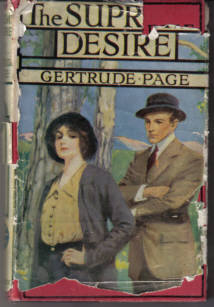
Her Times obituary reads:
A POPULAR NOVELIST- DEATH OF MISS GERTRUDE PAGE
Our Salisbury (Rhodesia) Correspondent announces the death there on Saturday of Miss Gertrude Page, the novelist. She was the daughter of Mr. John E. Page, of Woburn Sands and Bedford, and married Mr. Alexander Dobbin, who owns a cattle ranch in Rhodesia.
Miss Page was a voluminous writer of light dramatic novels which found a ready and considerable sale both in this country and the Dominions. Many of them dealt with life in the open air and were fashioned against the background which her husband’s ranch provided. The sentiment of her books, if not perhaps new in type, was always fresh and attractive. She saw much of the service asked by life of overstrained woman in a new country, and on that she could discourse with a knowledge and wisdom which found a ready response in the millions whom she numbered as her readers. Many of her descriptions were excellent, notably when she was depicting the seasons and scenes of her beloved Rhodesia. Of all her books the favorite is probably “Paddy the Next Best Thing,” of which more than 300,000 copies have been sold. A dramatized version of this book is now being played at the Savoy Theatre. Another of her novels, “The Edge o’ Beyond,” a glimpse of Rhodesian life, as Miss Page saw it, has also been dramatized and filmed.
Miss Page began to write when yet aged 11. Before reaching her teens she had formed a passion for long words and filled her stories with them. Later, when who began to do serious work, she developed an easy and sympathetic narrative style and insight into character. In addition to the works mentioned already, Miss Page wrote “The Supreme Desire” “The Silent Ranches,” “The Rhodesian,” “Some There Are,” and “Love in the Wilderness,” among many others.
Her husband came with her to this country during the war, and they gave lectures and readings on Rhodesia in military hospitals. Mr. Dobbin, in spite of many applications to enlist, though in sound health, and a first-class shot, was refused for the Army and became a voluntary Red Cross driver.
The Times Biographies records that Gertrude was a member of Empress Club.
In the book, “The Legend of Lomagundi”, by Colin Black, published by The North-Western Development Association Salisbury Rhodesia 1976, page 61 records:
“On the top of a granite Kopje in the Umvukwes lies a single grave. It is the resting place of Rhodesia’s first famous novelist Gertrude Page, and is close to the stone shelter in which she used to spend much time writing her best-selling stories of Rhodesia’s sun-soaked men and maidenly, yet flirtatious heroines. (One novel alone, “The Silent Rancher”, sold more than 275,000 copies. Her total sales exceeded 2 1/2 million copies, and plays adapted from two book were performed in London’s West End).
Marcel Mitton has said of her “In 1920 Gertrude Page became the first woman in the district to hold office in the Farmer’s Association. Her husband, Captain Dobbin, was a hot-tempered but warm hearted Irishman. He bought the ranch O’Meath from the BSA Company in 1910 and then brought his young wife, the daughter of a British MP, to Rhodesia. She was the second woman settler in the district, Mrs H.K. Bracewell being the first.
The house at O’Meath was on one side of the road, the kitchen on the other, so that the waiter had to scurry across the road with the meals. The door-less lavatory also faced the road, but fortunately there was not much traffic in those days!
Gertrude Page’s heroes were of the bronzed English Public School type, and the Hon. John Parker and Jack Fraser-Mackenzie, of the Lone Cow, no doubt presented her with plenty of material for two of her most popular novels, “Where the Strange Roads go Down” and “The Veldt Trail”. She always referred to them affectionately as the ‘Lone Calves’.
She herself was a good-looking, heavily built woman with piercing blue eyes. She preferred the company of men and always dressed in masculine looking coats and skirts. She was not only a literary celebrity but a politician, and spoke out fearlessly at a time when women did not take much part in public life. Gertrude Page helped Sir Charles Coghlan to obtain self-government for Rhodesia. She wrote her book “Jill’s Rhodesian Philosophy” when she first came to the country and was living near Salisbury on the farm Borrowdale Brook. She gave a sympathetic picture of what life was like for the women of those days, describing vividly the hardships and loneliness, the ugly homes of corrugated iron and brick, the lack of amenities and supplies. She described one of her first evening meals – ‘bully beef, potatoes, bread and treacle, the potatoes handed round in a tin basin’. Breakfast brought its own surprises – whisky, cheese and pickles, and the meal, said Gertrude Page, had ‘a tinny flavour – tinned milk, tinned butter, tinned jam, tinned fish, tin cups and saucers, and tin plates'”
Gertrude Page died, aged 50, after a stroke at Meikle’s Hotel in Salisbury in 1922. Her friend, Mrs Bracewell, was with her to the end. After the service in the Anglican Cathedral the coffin was taken by car to O’Meath, and then caried in an ox-wagon drawn by twelve black oxen to a grave cut in the granite kopje.
At the foot of the kopje lie the graves of some of the other early settlers, including that of Captain Dobbin, who was buried there in 1945.”
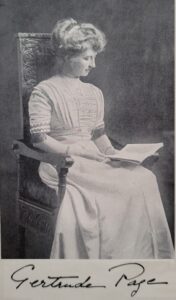
Published Books
The Mysterious Strangers – 1902. Four chapters, 28 pages. Quotes other works as “If Loving Hearts were Never Lonely”, “Her Sailor Lover” and “At Daggers Drawn”.
Love in the Wilderness The Story of Another African Farm – 1907. Inscription – “Beloved Father, perfect gentleman”.
The Edge of Beyond – 1908
Paddy the Next Best Thing – 1908
Silent Rancher – 1909
Jill’s Rhodesian Philosophy or The Dam Farm – 1910. Personal letters writen from Rhodesia under the name “Jill” describing life in Rhodesia.
Two Lovers and a Lighthouse – 1910. Inscription – “To a Work a day world in its thoughtful hours”
Winding Paths – 1911. Inscription – “To Ans”
The Great Splendour – 1912
The Rhodesian – 1912. Inscription – “To Cecil Rhodes and Victoria Falls”
Where the Strange Roads Go Down – 1913. Inscription – “To R A F-M Inspiring helper and Relentless critic”
The Pathway – 1914. Inscription – “To God Children Betty, Flora, Pat, Baby, carry the pathway for the Empire”
Follow After – 1915
Some There Are – 1916
The Supreme Desire – 1916
The Course of My Ship (With Foster-Melliar) – 1918
The Veldt Trail – 1919
Far From the Limelight (and other tales) – 1920
Jill on a Ranch – 1922
These were published by Hurst and Blackett or Ward Lock. She also had work published in Hutchinsons Magazine.
Wade Burgess has put together an amazing collection of her original book jackets and photos of Gertrude herself, which can be seen at: https://www.southafricabooks.com/authoresses/gertrude-page
Films
1919 – “Edge o’Beyond” – British silent film.
Directed by Fred W. Durrant. Writing credits Irene Miller and Gertrude Page. “Edge O’Beyond is a godforsaken speck somewhere in Colonial Africa. Heroine Dinah Webberley (Ruby Miller) is driven to near madness by the sadistic excesses of her aristocratic husband. When her baby dies and her husband feigns indifference, it’s the last straw. Dinah escapes into the jungle, caring little about her own well-being or survival. This adaptation of the novel by Gertrude Page was a strong pill to take for 1919 audiences accustomed to escapist entertainment.” Hal Erickson, All Movie Guide
Cast:
Ruby Miller as Dinah Webberley
Owen Nares – Dr. Cecil Lawson
Isobel Elsom – Joyce Grey
C.M. Hallard – Captain Burnett
Minna Grey – Dulcie Maitland
Fred Raynham – Oswald Grant
James Lindsay – Major Egerton
1920 – “Love in the Wilderness” – British silent film
Directed by Alexander Butler, for Samuelson Film Manufacturing Company. Produced by G.B. Samualson.
“Love story of an English girl, who has gone to live on her sister’s farm in Rhodesia and is wooed by a hot-tempered farmer. However, she prefers a married man, separated from his wife. After a violent struggle with the farmer, during which the latter dies and the girl is wounded, and after a letter arrives saying the married man’s wife has died, the lovers are united. Mrs Davenport is left with a young daughter, Enid, after her husband deserts her. Despite the loving support of an admirer, Neil Jefferson, and the care of her eldest daughter, Marion, Mrs Davenport dies, bequeathing her diary to Enid, who is left in the care of an aunt. Keith Meredith is persuaded by his father to marry Alice Hazlewood, against his better judgement. The marriage fails because of Alice’s unreasonable behaviour, which obliges Keith to send her away. Ten years later, Enid, now an attractive young woman, receives an invitation to join her sister in Rhodesia…” – All Movie Guide.
Cast:
George Whiting by Howard Davies
Nan Joynson – Maudie Dunham
Honorable Dick Byrd – Campbell Gullan
Mrs Davenport – Eugenie Besserer
Marion Davenport – Frances Griffiths
Keith Meredith – C. M. Hallard
Thomas, Keith’s manservant – Sydney Deane
Enid Davenport – Madge Titheradge
Mrs. Meredith (Keith’s wife) – Lynore Linard
1923 – “Paddy, the Next Best Thing” – British silent film
Screenwriter, Eliot Stannard; Screenwriter & Producer, Herbert Wilcox; Director, Graham Cutts; Cinematographer Rene Guissart.
“This lightweight comedy-drama is based on the stage play by Gertrude Page. Because her father (Sir Simeon Stuart) really wanted a boy, Paddy Adair (Mae Marsh in a blonde wig) becomes a hoydenish tomboy. Jack O’Hara (George K. Arthur) is in love with Paddy’s sister Eileen (Lillian Douglas), but Eileen loves Lawrence Blake (Darby Foster). Blake, meanwhile, loves Paddy. This tangled mass of misplaced affections begins to unravel when General Adair dies. O’Hara travels to South America to make his fortune, and Paddy travels from her home in Ireland to London. Blake follows after her, and eventually she comes to love him. O’Hara returns home, and Paddy goes home to see him. But while wandering off by herself she gets lost in a dense fog and is rescued by Blake. The story was changed around a bit and filmed as a musical in 1933 for Janet Gaynor.” Janiss Garza, All Movie Guide.
Cast:
Darby Foster as Lawrence Blake
George K. Arthur – Jack O’Hara
Haidee Wright – Jane O’Hara
Lillian Douglas – Eileen Adair
Mae Marsh – Paddy Adair
Marie Ault – Mrs Adair
Marie Wright – Mary O’Hara
Mildred Evelyn – Doreen Blake
Nina Boucicault – Mrs. Blake
Simeon Stuart – Gen. Adair
Tom Coventry – Mickey Doolan
1933 – “Paddy, the Next Best Thing” – Hollywood film
Director, Harry Lachman; Screenwriter, Dialogue Writer, Edwin H. Burke; Cinematographer, John F. Seitz. By Fox Pictures; 1hr 15min. A romantic romp about the adventures of a tomboy in New York City; scenes filmed along the coast south of Carmel, including Point Lobos.
“Gaynor stars as a spirited Irish lass whose older sister (Margaret Lindsay) is about to marry a wealthy gent (Warner Baxter). Fully aware that Sis doesn’t love the man, Gaynor sacrifices herself by marrying him instead–hence the “next best thing” part of the title. It takes about seven reels for Gaynor and Baxter to succumb to the inevitable and declare their true love for each other. Paddy, the Next Best Thing was a little bit of Heaven to Janet Gaynor’s fans, but mere Irish stew to everyone else” Hal Erickson – All Movie Guide.
Cast:
Janet Gaynor as Paddy Adair
Warner Baxter – Lawrence Blake
Walter Connolly – Major Adair
Harvey Stephens – Jack Breen
Mary McCormick – Herself
Fiske O’Hara – Mr. Davy
Merle Tottenham – Maid
Marie Ault
Trevor Blaid – Shelby
Trevor Bland – Sellaby
Roger Imhof – Micky
J.M. Kerrigan – Collins
Margaret Lindsay – Eileen Adair
Mae Marsh
Claire McDowell – Miss Breen
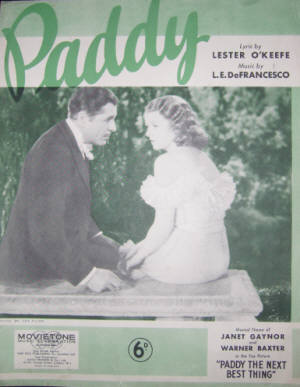
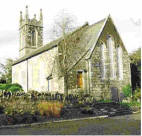
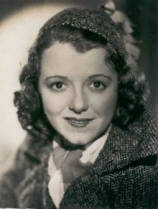
“Time” film review, 4th September, 1933:
“Paddy, the Next Best Thing” is very clearly Fox’s notion of the next best thing to Metro’s Peg 0’My Heart. It is an idyll of the Irish countryside, dripping with Hollywood blarney, Janet Gaynor’s girlish charm and terms of endearment like “acushla.” In the seaside village where such Gaelic trifles properly begin, Paddy Adair (Janet Gaynor) is the younger daughter of an improvident Major (Walter Connolly), who has succeeded in arranging a betrothal between his eldest daughter Eileen (Margaret Lindsay) and handsome Larry Blake (Warner Baxter), who has a Rolls Royce and a yacht. When she learns that Eileen loves not Larry Blake, but a poor boy of the village named Jack Breen, Paddy does her loveable best to break the engagement. She snubs Blake, then flirts with him, finally tells him in plain terms why her sister is marrying him. All this has a good effect. After her father has been kicked to death by one of his horses, Eileen marries Jack Breen. Larry Blake decides that not Eileen but Paddy is his real acushla and persuades her that she loves him also. To this assiduously elfin but capably assembled production, Walter Connolly contributes a few genuine moments – like the one in which, with shamefaced grins at his daughters, Major Adair borrows £3 from Larry to pay for a box of cigars.”
Theatre Productions
1920 – “Paddy the Next Best Thing” – Broadway
Produced by Robert Courtneidge, written by Gayer Mackay and Robert Ord, and staged by Robert Courtneidge.
Broadway Shubert Theatre, Opened: Aug 27, 1920, closed: Oct 1920. Total Performances: 54. Setting: The Ghan House, Dr. Davy’s Dispensary and a carriage on the L. & N.W. Ry.
Cast:
Alice Belmore Cliffe as Mrs. Putter
Walter Edwin – General Adair
Eunice Elliott – Eileen Adair
Vera Finlay – Gwendoline Carew
Eileen Huban – Paddy
Hugh Huntley – Jack O’Hara
Emily Lorraine – Mrs. Bingle
Mureen Maguire – Webb
Charles McCarthy – Micky
C. Bernard Moore – Lord Sellaby
Kitty O’Connor – Doreen Blake
Cyril Scott – Laurence Blake
J. B. Souther – Ticket Taker
Julia Stuart – Miss O’Hara
Charles B. Wells – Dr. Davy Adair
Isabel West – Miss Mary O’Hara
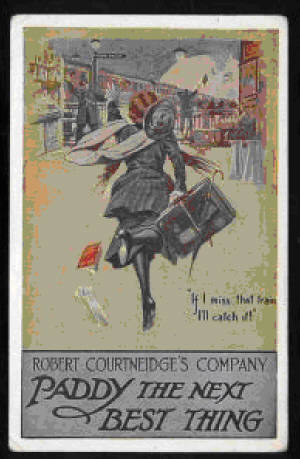
1920 – “Paddy the Next Best Thing” England
Robert Courtneidge’s company had also staged the play in England, opening at The Savoy Theatre, London on April 5th, 1920. Produced by Robert Courtneidge, written by Gayer Mackay and Robert Ord, adapted from Gertrudes book. Peggy O’Neil starred as Paddy.
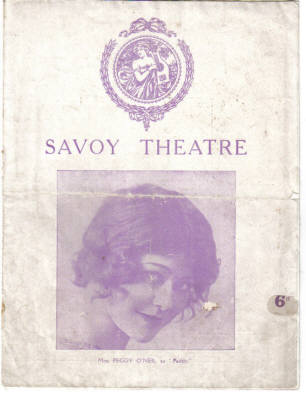
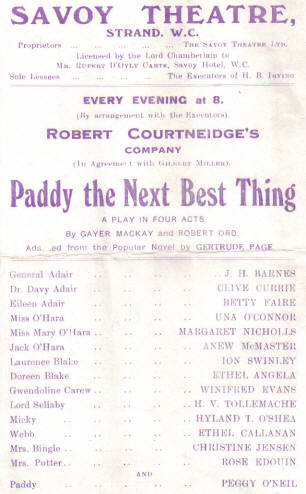
The 221st edition of The Play Pictorial, the theatre magazine, was devoted to the production, and featured many photos of the cast in scenes from the play.
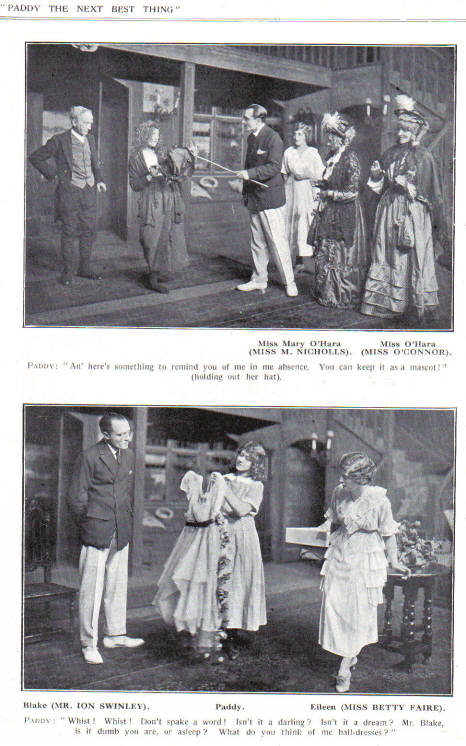
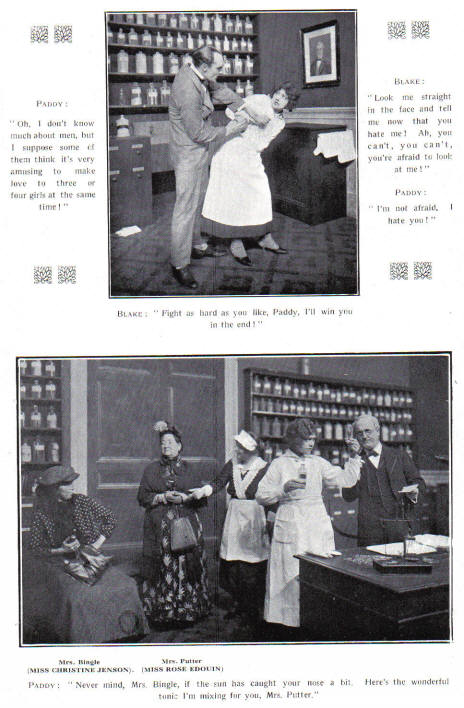 In a classic ‘love/hate relationship, Paddy eventually admits to loving Blake!
In a classic ‘love/hate relationship, Paddy eventually admits to loving Blake! 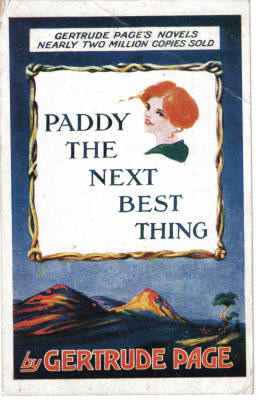 “Paddy the Next Best Thing” was also staged in Manchester, but I have not been able to find out any details of this production, all I have is this postcard, advertising the performances at The Opera House (Queens Theatre), for two weeks, from 11th October 1920, nightly at 7.15pm and matinees Wednesdays at 2pm.
“Paddy the Next Best Thing” was also staged in Manchester, but I have not been able to find out any details of this production, all I have is this postcard, advertising the performances at The Opera House (Queens Theatre), for two weeks, from 11th October 1920, nightly at 7.15pm and matinees Wednesdays at 2pm.
1921 “The Edge of Beyond” – The Garrick, London
By Roy Horniman and Ruby Miller (novel by Gertude Page), Basil Rathbone played Dr. Lawson and starred with Doris Lloyd in 150 performances.
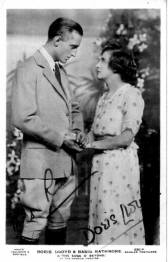
Many thanks to Barbara Battel-Kirk, who grew up in Omeath, Co. Louth, where “Paddy The Next Best Thing” is set, for providing some of the data and images above.
Page last updated Nov. 2022.
